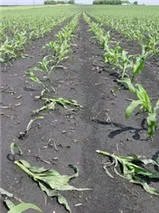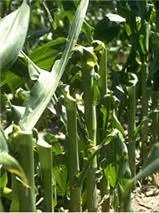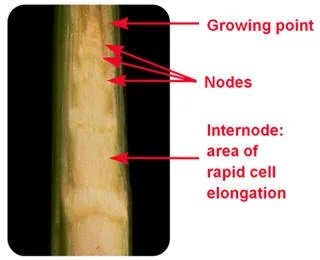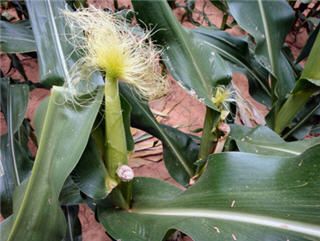Brittle snap injury in corn
BackSummary
- Brittle snap or breakage of corn stalks is most likely to occur when high speed blustery winds occur during a violent seasonal storm.
- The two most common periods for brittle snap damage are V5 to V8, when the growing point is just advancing above the soil line, and V12 to R1, or two weeks prior to tasseling until silking.
- Many factors affect the severity of brittle snap injury, including growing conditions, field geography, crop management practices and soil type.
- Growth regulator herbicides can increase the incidence and severity of brittle snap injury by impacting cell division in the nodal area and increasing stalk brittleness.
- To spread the risk of brittle snap, growers should consider planting more than one hybrid or maturity group (CRM) and manage growth regulator herbicides very carefully.
- Australia screens potential new hybrids over many different locations throughout Australia for several years prior to commercial release.
What is brittle snap?
Brittle snap” or “green snap” refers to breakage of corn stalks by violent winds, most often occurring during periods of rapid vegetative growth. Although uncommon in Australia, this weather-related phenomenon is reported most frequently in regions where very high speed or violent winds occur during the storm season.
During corn’s vegetative growth phase, rapidly elongating internodes are often brittle and susceptible to breakage. The two most common periods for brittle snap damage are V5 to V8, when the growing point is just advancing above the soil line, and V12 to R1, or two weeks prior to tasseling until silking (Figure 1). Brittle snap damage to corn has occurred as long as corn has been grown.

Figure 1. Snapped corn plants. V5 to V6 growth stage.
Brittle snap injury at V5 to V8 (25 to 75 cm)
A corn plant at V5 (five visible leaf collars) is entering a period of rapid change. The growing point is just emerging above the soil, making the plant vulnerable to damage. The nodal root system is beginning to expand rapidly, greatly increasing the plant’s ability to take up water and nutrients to support accelerated plant growth. Rapid leaf and stalk growth follows this root system expansion. Stalk growth occurs by elongation of internode cells, which increases the rigidity of the stalk. Cell walls are extremely fragile at this rapid-growth stage and stalk tissues are at a greater risk of brittleness compared to other growth stages.
At the V5 to V8 stage, many nodes and internodes are arranged together in a small area (Figure 2). This dense concentration may make the plants less flexible and more susceptible to breakage. Brittle snap observed at this stage often follows a surge in corn growth and development stimulated by favorable rainfall and temperature.
Brittle snap breakage at V5 to V8 occurs below the growing point, at a stalk node at or near the soil surface (Figure 1).
Snapped plants will not recover, nor contribute appreciably to yield. Tillers may emerge in subsequent weeks, but in most cases will not set harvestable grain, even though they may resemble a small corn stalk. Impact on yield will vary according to severity of stand reduction and subsequent growing conditions.
Yield reduction from brittle snap at the V5 to V8 stage is often less than that occurring when the same number of plants are snapped near the tassel stage. One reason may be that remaining plants have more time and resources (sunlight, nutrients and moisture) to compensate for lost stand when injury occurs earlier in the growing season.

Figure 2. Snapped corn plants. VT (tassel) growth stage.
Yield reduction from brittle snap at the V5 to V8 stage is often less than that occurring when the same number of plants are snapped near the tassel stage. One reason may be that remaining plants have more time and resources (sunlight, nutrients and moisture) to compensate for lost stand when injury occurs earlier in the growing season.
Brittle snap damage at V12 through to tasseling
From V12 through tasseling, the corn plant is undergoing its most rapid stage of growth. It will increase in size from 90 cm to its mature height of 210 to 300 cm in approximately 21 to 28 days, or about 5 to 10 cm of growth per day. A key factor increasing the incidence of brittle snap at this stage is the enlargement in leaf surface area and plant height, which increases wind resistance during a period of potential severe thunderstorms and wind events. The most common sites for breakage at this stage are at the nodes – immediately below, at or above the primary ear node.
Plants snapped at this stage often have visible ear shoots on the stalk shortly after the wind damage event (Figure 3). However, the severely reduced leaf surface area usually results in limited or no grain production on injured plants. Upon reaching mature height the risk of brittle snap diminishes as cell walls are strengthened by the deposition of lignin and other structural materials.
Brittle snap severity affected by many factors
The most important factor influencing brittle snap damage is the timing and severity of windstorms. Damaging winds often occur in a burst ahead of the rain. Dry, firm soil that tightly anchors the crown and roots of the plant at this time may result in increased breakage. In the same way, strong-rooted hybrids may incur more damage if the plant is prevented from “giving” at the base.
After a severe windstorm, growers often ask why one field has damage when a neighbouring field with the same hybrid does not. This is likely because straight line winds can be highly variable across small geographies. This phenomenon is obvious when observing damage to telephone poles, trees or buildings after a storm, so it is not surprising that it applies to corn fields as well. Wind “currents” and “downbursts” result in narrow zones of destruction that often cause more severe damage in one area than another.
In addition to wind impact, any factor that stimulates, or conversely, hinders corn growth and development prior to the wind event can influence the incidence or severity of brittle snap injury. This includes growing conditions, crop management practices, field characteristics, genetics and herbicides.
When severe thunderstorms occur that result in widespread wind damage, it is important to sort out the contributing factors. Integral to the diagnosis is an accurate assessment of the field’s historical risk of injury. If the field is in an area that frequently experiences hail or thunderstorms associated with high winds, the annual risk may be greater than if the field is in an area that has rarely or never experienced brittle snap damage. Severe storms that cause breakage often have wind speeds of more than 100 km per hour. Such storms occur at a higher frequency than many expect. Storms with high winds usually occur during the classic “thunderstorm season”.
Factors affecting brittle snap severity:
- Timing and severity of windstorms
- Growth conditions prior to the storm, such as temperature and soil moisture
- Crop management practices including tillage, fertility, plant population, row spacing and row direction
- Field characteristics such as topography and soil type
- Hybrid genetics
- Herbicide interactions
Even small differences in management or environment can impact the extent of damage, sometimes dramatically. One commonly observed example is planting date. For wind- storms occurring at the V5 stage, even a small delay in plant development may result in protection to the growing point by the soil at the time of the wind event. Another example is temperature. Brittleness is greatest in rapidly growing corn under high temperature, high soil moisture conditions. Quick temperature changes that result in a sudden increase in corn growth may dramatically increase the risk of breakage.

Figure 3. Dissected corn plant showing the developing structures inside the stalk, including the growing point, nodes and internode area.
Any conditions which promote high yield and rapid growth may, unfortunately, also promote greater brittle snap damage. In fact, it is often the most productive fields with the highest yield potential that incur damage. A long-term study on nitrogen fertiliser rate, tillage and application timing at the University of Nebraska provided an opportunity to evaluate these factors when windstorms occurred (Ferguson, 1995). A July storm produced wind speeds up to 100 mph in 1993, and wind speeds up to 90 mph were recorded in a July, 1994 storm.
In both years of wind damage, breakage increased with increasing nitrogen rates. Damage was greater when nitrogen was applied preplant versus sidedress. Damage in both years was also greater under conventional tillage then no-till. Ferguson concluded that “factors which accelerated crop growth early in the growing season also increased the susceptibility of the crop to stalk breakage.” When evaluating hybrid differences or unexpected hybrid responses (positive or negative) after a wind event, it is important to assess the genetic, cultural, weather and geographic factors that may have influenced the specific experience in that field.
The V5 to V8 stage of development (approximately 10- to 24-inch corn) often coincides with or is followed by the application window for postemergence herbicides. Growth regulator herbicides such as 2,4-D, dicamba or clopyralid control weeds by the disruption of several growth processes including cell enlargement, cell division, protein synthesis and respiration.

Figure 4. Plants snapped at VT may develop ear shoots, but little contribution to yield is expected.
Growth regulator herbicides are translocated in both the xylem and the phloem to meristematic regions – areas of cell division and rapid growth – in both shoots and roots. The stalk nodes of corn are meristematic regions. Other meristematic regions in corn under rapid growth at this time are the developing ears, nodal roots and brace roots. Corn injury symptoms such as the malformation of brace roots and the temporary leaning and twisted appearance of plants shortly after application are due to the effect of these herbicides on the meristematic areas of the plant. Growth regulator herbicides can also increase the incidence and severity of corn brittle snap injury by impacting cell division in the nodal areas and increasing brittleness.
Genetic differences do exist among hybrids for brittle snap injury. In exploring these differences, agronomists have often noted a relationship between rapid early growth and a hybrid’s tendency towards brittleness in the early window for breakage (V5 to V8). However, there appears to be less of a relationship between early growth characteristics and increased risk of brittle snap in the near-tassel period. Some hybrids with comparatively slow early growth show increased risk, while other hybrids with relatively fast early growth have exhibited limited risk of injury at this stage.
Managing the risk of brittle snap injury
Because brittle snap is a weather-related phenomenon, it is impossible to completely manage its risk. However there are ways to reduce the risk of brittle snap injury:
- Plant more than one of hybrid or maturity every year. Hybrids that differ in maturity go through their windows of susceptibility to brittle snap injury at different times. Planting a package of diverse hybrids spreads the risk of injury, as it is unlikely that all hybrids will be at the same stage of development at the time of any one storm.
- Manage herbicide programs to minimise risk. Application of growth regulator herbicides, either alone or as part of a tank mix combination, can increase the risk of brittle snap injury. Recognize that surfactants and nitrogen additives increase uptake and translocation of the herbicide in the corn plant, just as they do in target weeds. Additives can increase weed control, but can also increase your risk of crop injury. Always follow label instructions for proper rates and types of adjuvants.
- Plant seed at proper depth. Planting depth does not directly influence brittleness; however, planting to shallow can restrict nodal root development. One tolerance mechanism of corn for dicamba is exudation from roots (Fawcett, 1992). Corn plants with shallow or restricted root systems may experience decreased tolerance to dicamba, leading to increased risk of brittle snap or other injury symptoms such as brace root malformation. Planting at a minimum of 1.5 to 2 inches deep will encourage normal nodal root development and help alleviate these concerns.
- Evaluate crop insurance options in cases of increased risk of brittle snap (susceptible fields or hybrids).
Pioneer Australia’s hybrid testing for brittle stalk
Unfortunately, all hybrids under the right environmental conditions and sufficient wind speeds can suffer brittle snap damage. There are no hybrids completely resistant to brittle snap, just as there are no hybrids resistant to hail, flood or many other weather-related causes of crop loss.
Pioneer Australia does screen all of its pre- commercial hybrids for Brittle Snap over multiple geographical locations for several years prior to release. Pioneer employs a continuous, incremental approach to hybrid yield and trait improvement, including brittle snap resistance. Pioneer’s goal of bringing better products to customers faster to enhance productivity and profits.
References and further reading
Elmore, R. and L. Abendroth, 2006. Greensnap in Iowa. In Integrated Crop Management newsletter IC-498(19), July 10, 2006 issue. Iowa State University Extension. Available online:
http://www.ipm.iastate.edu/ipm/icm/2006/7-10/greensnap.html
Fawcett, R.S. 1992. Corn breakage why and how. Fawcett Consulting.
CN0623-03A
Your seed is backed by
local experience
With dedicated and highly skilled team members located throughout Australia you can be sure of accessing the best local knowledge to help you maximise your investment in Pioneer® brand hybrid seed. Get in touch with your local Territory Sales Manager or Farm Services Consultant today.
